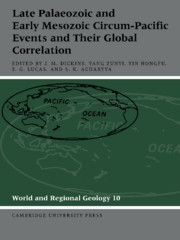Book contents
- Frontmatter
- Contents
- List of contributors
- Preface
- 1 Major global change: framework for the modern world
- 2 Carboniferous-to-Triassic evolution of the Panthalassan margin in southern South America
- 3 Permian and Triassic geologic events in Sonora, northwestern Mexico
- 4 Advances in the correlation of the Permian
- 5 Examples of late Hercynian transtensional tectonics in the Southern Alps (Italy)
- 6 Succession of selected bioevents in the continental Permian of the Southern Alps (Italy): improvements in intrabasinal and interregional correlations
- 7 Permian chronostratigraphic subdivisions and events in China
- 8 Indosinian Tectogeny in the geological correlation of Vietnam and adjacent regions
- 9 Sitsa flora from the Permian of South Primorye
- 10 Late Permian bimodal volcanism in South Primorye
- 11 Syngenetic and epigenetic mineral deposits in Permian and Triassic sequences of the Primorye region
- 12 The mid-Permian: major changes in geology, environment, and faunas and some evolutionary implications
- 13 Variations in the disappearance patterns of rugosan corals in Tethys and their implications for environments at the end of the Permian
- 14 Fluctuations in pelagic environments near the Permian–Triassic boundary in the Mino-Tamba Terrane, southwest Japan
- 15 Late Changxingian ammonoids, bivalves, and brachiopods in South Primorye
- 16 Radiolaria from Permian–Triassic boundary beds in cherty deposits of Primorye (Sikhote-Alin)
- 17 Early Mesozoic magmatism in the Russian Far East
- 18 Transgressive conodont faunas of the early Triassic: an opportunity for correlation in the Tethys and the circum-Pacific
- 19 Triassic biostratigraphy and palaeobiogeography of East Asia
- 20 Classification and correlation of Triassic limestones in Sikhote-Alin on the basis of corals
- 21 Evolution of the platform elements of the conodont genus Metapolygnathus and their distribution in the Upper Triassic of Sikhote-Alin
- 22 Late Triassic North American halobiid bivalves: diversity trends and circum-Pacific correlations
- 23 Upper Triassic Chinle Group, Western United States: a nonmarine standard for late Triassic time
- 24 Otapirian Stage: its fauna and microflora
- 25 Upper Palaeozoic glaciation and Carboniferous and Permian faunal changes in Argentina
- Index
16 - Radiolaria from Permian–Triassic boundary beds in cherty deposits of Primorye (Sikhote-Alin)
Published online by Cambridge University Press: 13 October 2009
- Frontmatter
- Contents
- List of contributors
- Preface
- 1 Major global change: framework for the modern world
- 2 Carboniferous-to-Triassic evolution of the Panthalassan margin in southern South America
- 3 Permian and Triassic geologic events in Sonora, northwestern Mexico
- 4 Advances in the correlation of the Permian
- 5 Examples of late Hercynian transtensional tectonics in the Southern Alps (Italy)
- 6 Succession of selected bioevents in the continental Permian of the Southern Alps (Italy): improvements in intrabasinal and interregional correlations
- 7 Permian chronostratigraphic subdivisions and events in China
- 8 Indosinian Tectogeny in the geological correlation of Vietnam and adjacent regions
- 9 Sitsa flora from the Permian of South Primorye
- 10 Late Permian bimodal volcanism in South Primorye
- 11 Syngenetic and epigenetic mineral deposits in Permian and Triassic sequences of the Primorye region
- 12 The mid-Permian: major changes in geology, environment, and faunas and some evolutionary implications
- 13 Variations in the disappearance patterns of rugosan corals in Tethys and their implications for environments at the end of the Permian
- 14 Fluctuations in pelagic environments near the Permian–Triassic boundary in the Mino-Tamba Terrane, southwest Japan
- 15 Late Changxingian ammonoids, bivalves, and brachiopods in South Primorye
- 16 Radiolaria from Permian–Triassic boundary beds in cherty deposits of Primorye (Sikhote-Alin)
- 17 Early Mesozoic magmatism in the Russian Far East
- 18 Transgressive conodont faunas of the early Triassic: an opportunity for correlation in the Tethys and the circum-Pacific
- 19 Triassic biostratigraphy and palaeobiogeography of East Asia
- 20 Classification and correlation of Triassic limestones in Sikhote-Alin on the basis of corals
- 21 Evolution of the platform elements of the conodont genus Metapolygnathus and their distribution in the Upper Triassic of Sikhote-Alin
- 22 Late Triassic North American halobiid bivalves: diversity trends and circum-Pacific correlations
- 23 Upper Triassic Chinle Group, Western United States: a nonmarine standard for late Triassic time
- 24 Otapirian Stage: its fauna and microflora
- 25 Upper Palaeozoic glaciation and Carboniferous and Permian faunal changes in Argentina
- Index
Summary
When considering the problem of determining the Permian–Triassic boundary, one usually uses data on ammonoids, conodonts, bivalves, and, more rarely, brachiopods. Data concerning the character of radiolarian development have not often been used, because representatives of that group are absent from the carbonate-terrigenous deposits of the Permian–Triassic boundary beds in the most representative sections in southeastern China (Yang Zunyi and Li Zishun, 1992), the Transcaucasus (Zakharov, 1992), Iran (Bando, 1979), and the Himalayas (Kapoor, 1992).
Recently, Permian and Triassic Radiolaria from cherty sequences in Japan (Nakaseko and Nishimura, 1979; Caridroit, 1986; Ishiga, 1986, 1990) and Sikhote-Alin (Rudenko and Panasenko, 1990a,b,c; Bragin, 1991; Rudenko, Panasenko, and Rybalka, 1992) have received intensive study. However, a serious obstacle to solving the boundary problem arises because of the absence of radiolarians and conodonts immediately above the Permian–Triassic boundary beds within the discrete cherty plates that are common in the olistostrome terranes of the circum-Pacific.
In Tonishi-type shales in the Ashio Mountains, central Japan, the radiolarian Neoalbaillella is found in Lower Dorashamian grey and dark-grey platy cherts, and conodonts are found in Lower Triassic (Smithian) grey cherty argillites (Yamashita, Ishida, and Ishiga, 1992; Sashida, Kamata, and Igo, 1992). A similar picture is seen in Sikhote-Alin.
Recently, we found Permian Radiolaria on the Pantovyi Creek left bank (Taukha Terrane, Tumanovka River basin, 300 m to the west of Zarod Mountain).
- Type
- Chapter
- Information
- Late Palaeozoic and Early Mesozoic Circum-Pacific Events and their Global Correlation , pp. 147 - 151Publisher: Cambridge University PressPrint publication year: 1997



